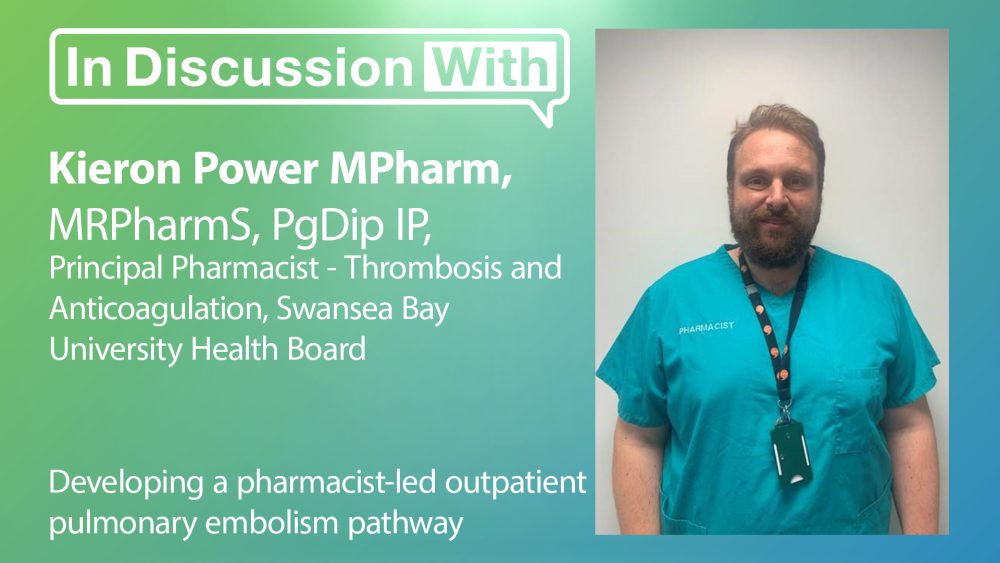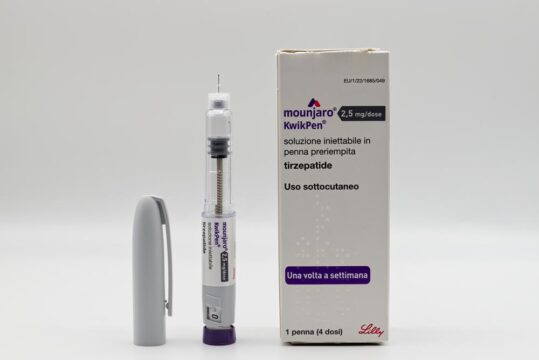Advertisment
Developing a pharmacist-led outpatient pulmonary embolism pathway

Kieron Power is Principal Pharmacist for Thrombosis and Anticoagulation in Swansea Bay University Health Board in South Wales. He has played a leading role in the development of an outpatient pulmonary embolism pathway that has positively impacted the service and the patient experience. In this series of short videos, he describes how this came about and the contribution that pharmacist make to patient care in this field.
Pulmonary embolism – what patients experience
The two most common forms of venous thromboembolism (VTE) are deep vein thrombosis (DVT) and pulmonary embolism (PE). In the UK, about 39 to 115 per 100,000 of the population each year will develop a PE and the mortality rate can be up to 30%. However, “what we’ve started to realise in recent times is that not all PEs are the same and actually there’s distinct groups within that bracket”, says Mr Power. Patients with high-risk (usually large) PEs are critically unwell and require hospital admission. Patients with low-risk (usually small) PEs can often be managed as outpatients.
How are high and low-risk pulmonary embolisms diagnosed and managed?
A computed tomography pulmonary angiogram (CTPA) is now the first line diagnostic modality for suspected pulmonary embolism, explains Mr Power. It allows clinicians to identify large and small pulmonary emboli.
In the past there were significant inconsistencies in the management of PE. For example, 50% of DVT patients in Swansea did not receive any follow-up. The 2019 NCEPOD report of PE management identified similar inconsistencies nationwide. In 2020 the British Thoracic Society (BTS) published quality standards for outpatient PE management and the team in Swansea used this a prompt to review its own services and a catalyst to develop the new service.
How the pulmonary embolism pathway ensures consistent decision-making
The pulmonary embolism pathway has been designed to ensure acute risk assessment and appropriate follow up for all pulmonary embolism patients whether treated as inpatients or outpatients.
Routine risk assessment using the PE severity index (PESI) was introduced for all PE patients. In addition, seven-day and long-term follow-up was put in place. Steps were also taken to ensure that that those patients who initially required hospital admission later entered the same standardised follow-up pathway.
The Swansea model differs from others in that it covers the whole pathway in an integrated way rather than separating the acute phase and the follow-up phase. “So, we have this ideal pathway from day one to month three. Patients will come into that pathway at different points but the idea is that eventually we reach the same point and because it’s the same group of clinicians doing it, we get the consistency. …. Every patient referred into the service – it doesn’t matter from which point – they will have that input and they’ll have that consistency of decision making”, says Mr Power.
What impact has the pulmonary embolism pathway had?
During the 12-month period September 2022 to the end of August of 2023 some 300 pulmonary embolism (PE) referrals were received. Of these, 89 were managed as ambulatory patients; the 30-day readmission rate was 4% and only 3% required referral to the respiratory team.
At the critical seven-day review, patients undergo a full clinical assessment. As this is done in the Same-Day Emergency Care (SDEC) unit there is immediate access to other specialists if the patient’s clinical status is declining.
One of the biggest challenges was tackling his own strongly-held view that further development of pharmacists’ advanced practice skills was required. A framework for practice has now been developed together with an extensive training programme. The advanced practice training ensures that “we actually add things on to our skills to make us better as prescribing clinicians within that area”, says Mr Power.
How to establish a sustainable pulmonary embolism service
A number of features have contributed to the success of the pharmacy-led outpatient PE pathway including a close working relationship with the doctors, the systematic delivery of seven-day follow-up and pharmacists’ acquisition of advanced practice skills.
Pharmacists now make all the decisions about duration of anticoagulation. As a result, some registrars and other junior doctors have sat in on pharmacists’ clinics – an experience that Mr Power says has been mutually beneficial.
Anecdotal feedback from patients suggests that those who have gone through the ambulatory pathway tend to be less anxious. “Patients really do seem to respond really well to the service and are very appreciative of having that prompt follow-up”, says Mr Power.
The PE pathway “was the natural next step to ensure that we have a fully comprehensive VTE service which is addressing all of the most common presentations of VTE and offering a high-quality service …. that’s delivering good patient outcomes and is sustainable”, he says. The current arrangement is funded to provide 37.5 hours per week of VTE service, he adds.
The main priority for the immediate future is to develop further the working framework and training process. Mr Power hopes that in future this might form the basis of a national training framework for pharmacists and other health care professionals who wish to work in this area.
About Kieron Power
Kieron Power is Principal Pharmacist for Thrombosis and Anticoagulation in Swansea Bay University Health Board in South Wales. His role comprises three elements:
- Thrombosis and Anticoagulation Lead for the health board – a governance role that involves leading on policy and guidance within the Health Board and performance monitoring for hospital-acquired thrombosis rates, venous thromboembolism risk assessments and general anticoagulation prescribing factors.
- Running a weekly thrombosis and anticoagulation specialist clinic on behalf of the consultant haematologists.
- Leading and running the pharmacist-led acute VTE service and follow-up service that operate within the health board
Read and watch the full series on our website or on YouTube.
This episode of ‘In Discussion With’ is also on Spotify. Listen to the full podcast now.





